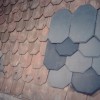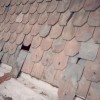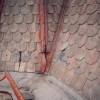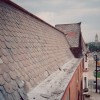Slate Shingles
Slate is a very stable natural material. It is thermally stable and not readily changed by chemical or biological reaction. Slate comes in various colors, usually in shades of pale grey to dark grey, although it may also be purple, green or cyan depending on where it's mined. Slate is quarried all over the world, either by open-pit mining or by tunneling. In the U.S., slate is extracted from eastern Pennsylvania, Virginia, New York, Vermont and Main. This fine grained material was originally composed of clay or volcanic ash in prehistoric ocean beds. Through millions of years of pressure and extreme heat, known as metamorphism, it turned into what is known as slate. Because of the natural way in which slate can be split along its planer axis and yet still maintain its integrity, slate has been adapted very well to the building industry.
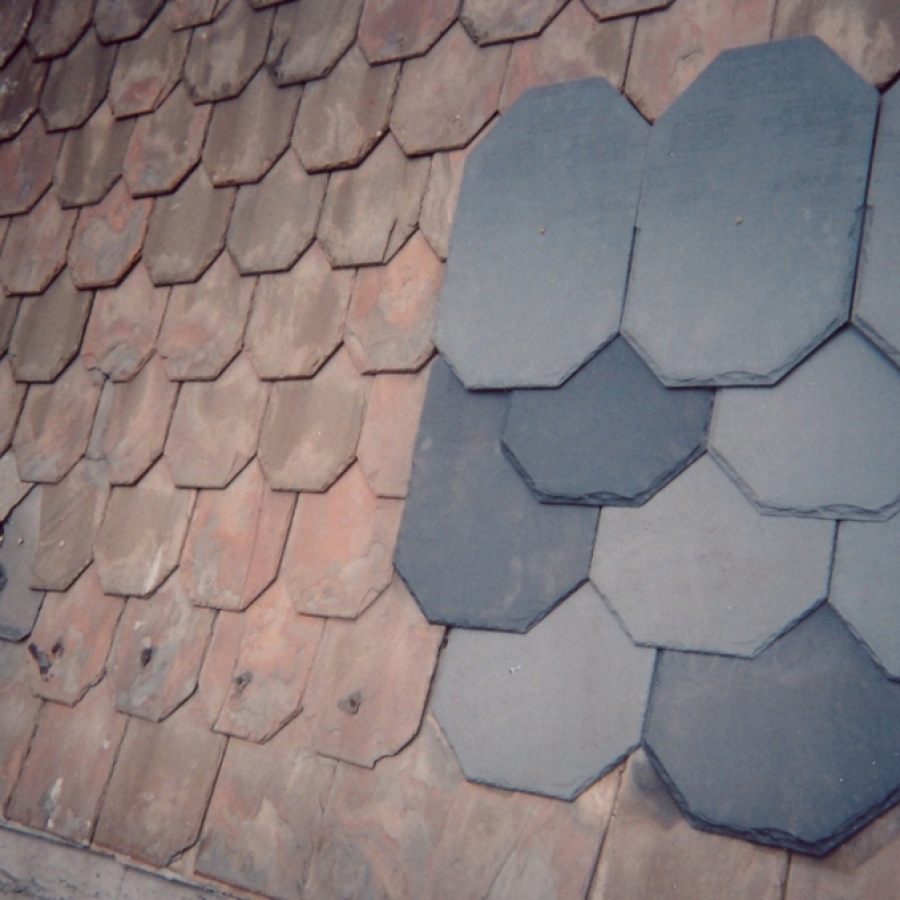
Topic Summary
As early as the early 1600's in the United States, slate was imported from Europe, most of it coming from Wales in the United Kingdom. With these imports also came the highly skilled laborers needed to install slate shingles. The U.S. quarries enjoyed a dramatic increase in production up through the late 1890’s. However, by the early 20th century, slate had begun to give way to new roofing materials, such as the asphalt and asbestos shingle. The skilled installers, know as slaters, all but disappeared.
As might be expected, the weight of slate needs to be taken into account. The structure of the roof will need to support loads ranging anywhere from 700 pounds per square to as much as 8,000 pounds per square. A square in roofing terms is defined as a sufficient number of slate shingles of any size to cover 100 square feet of plain roofing surface, when laid with the approved or customary standard headlap of 3 inches.
There are three types of slate roof systems as defined by National Roofing Contractors Association (NRCA):
- Standard Slate Roof - 3/16 inch to 1/4 inch thick slate shingles having uniform lengths and widths and square tails which provide a standard exposure.
- Graduated Slate Roof -slate roofing shingles that vary in thickness, size and exposure. The larger tiles are placed along the eaves and gradually diminish in size as they reach the ridge. This illusion gives the appearance that the roof is longer than it actually is.
- Textural Slate Roof - slate shingles of various thicknesses placed in a random pattern throughout the roof. Also, slate shingles with rougher surface and uneven tails can create a textural slate roof system.
The most common use of slate is to provide protection from the natural elements as a roofing material. Other uses of slate include applications for interior and exterior flooring, stairs, walkways, wall tiles and gravestones. However, when using slate tiles as a flooring material, the floor can become slippery when subjected to rain or moisture. Slate has also been used been used for laboratory countertops, for billiard tables, and as blackboards in schools.
Standards
- ASTM C 120, "Standard Test Methods of Flexure Testing of Slate (Modulus of Rupture, Modulus of Elasticity)"
- ASTMC 121, "Standard Test Method for Water Absorption of Slate"
- ASTM C 217, "Standard Test Method for Weather Resistance of Slate"
- ASTM C 406, "Standard Specifications for Roofing Slate" describes the three grades of roofing slate.
Grade S1 - properties that provide for an expected service life of more than 75 years (some S1 grade slate roofs have lasted more than 300 years).
Grade S2 - properties that provide for an expected service life of 40 to 75 years.
Grade S3 - properties that provide for an expected service life of 20 to 40 years.
Design considerations and terminology
- Roof deck - Either wood planks, boards or structural wood panels.
- Roof slope recommendations -NRCA recommends a slope of 4:12 (18 degrees) or greater.
- Fasteners - 10 gauge copper or stainless steel. Slate shingles are meant to hang from the nails.
- Exposure and appearance - That portion of the slate shingle that is not covered by the course above it. The correct exposure is obtained by subtracting the 3 inch headlap from the total length of the shingle then dividing that number by two.
- Flashings and penetrations - These are critical to the success of the slate shingle roofing system. Flashings will occur at the perimeter, at valleys and penetrations.

Buildipedia Staff
The Buildipedia research and writing staff consists of dozens of experienced professionals from many sectors of the industry, including architects, designers, contractors, and engineers.
Website: buildipedia.com/
